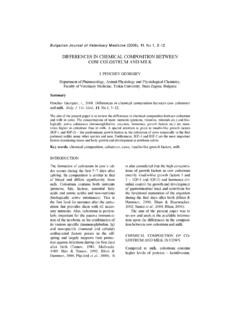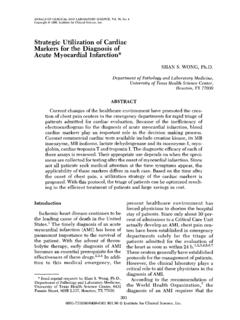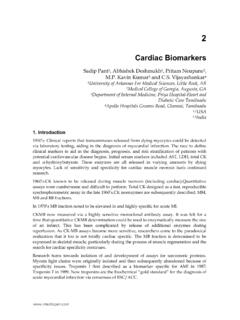Transcription of Laboratory Diagnosis of Acute Myocardial Infarction
1 Trakia Journal of Sciences, Vol. 3, No. 1, 2005 8 Trakia Journal of Sciences, Vol. 3, No. 1, pp 8-14, 2005 Copyright 2005 Trakia University Available online at: ISSN 1312-1723 Mini-review Laboratory Diagnosis OF Acute Myocardial Infarction A. Ruseva* Central Clinical Laboratory , University Hospital, Pleven, Bulgaria ABSTRACT The early recognition of cardiac ischemia and accurate placement of the patient in the risk spectrum of the Acute coronary syndrome are critical to the effective management of patients with Acute Myocardial Infarction (AMI). Apart from clinical history, physical examination and accurate ECG interpretations, cardiac biomarkers are equally valuable in the initial evaluation of patients with non-traumatic chest pain.
2 Previously the Diagnosis of an AMI was based on World Health Organisation (WHO) criteria which defined MI as the presence of two out of three characteristics comprising: symptoms of Acute ischemia (chest pain), development of Q waves in ECG and elevated activities of traditional serum enzymes comprising: total CK, CK-MB, ASAT and LDH. An ideal biomarker should have the following characteristics: relatively high concentration within cardiac tissue, have no significant tissue sources other than the heart, have high clinical sensitivity and specificity, be detectable in the blood early after the onset of chest pain, have elevated blood levels for several days after the onset of symptoms, and have an assay with a quick turnaround time.
3 Since no single biomarker fulfils all of these criteria, the NACB proposes the use of two biomarkers for the Diagnosis of AMI: an early marker myoglobin and a definitive marker - cardiac troponins. When cardiac troponin is not available, the next best alternative is CK-MB (measured by mass assay). Key Words: AMI, Laboratory Diagnosis , troponin, myoglobin, CK-MB When a patient presents with chest pain in the emergency department, physicians must consider a continuum of Acute coronary syndromes which could include the following: non- cardiac chest pain, unstable angina in which oxygen deprivation occurs without permanent damage to heart muscle and heart attack or Myocardial Infarction (MI) with permanent heart muscle damage If patients with chest pain are not properly evaluated, then some patients without an Acute coronary event will be inappropriately admitted, while patients experiencing an AMI may be discharged[25].
4 Critical to the effective management of these patients are the early recognition of a cardiac ischemia event and the proper placement of the patient in the risk spectrum of the Acute coronary syndrome [20]. The objectives of the initial evaluation of patients with non-traumatic chest pain are twofold: Correspondence to: Adelaida Ruseva, MD. Central Clinical Laboratory , University Hospital, 8-A G. Kotchev Str., 5800 Pleven; E-mail: 1. To assess the probability that the patient s symptoms are related to Acute coronary ischemia. 2. To assess the patient s risk of recurrent cardiac events, including death and recurrent ischemia [5].
5 Diagnosis of an AMI in the past, during the early 1990s, utilised the World Health Organisation (WHO) criteria defining MI as the presence of two out of three characteristics: symptoms of Acute ischemia (chest pain); development of Q waves in ECG; elevation of traditional enzyme activities in serum: total CK, CK-MB, ASAT and LDH [4, 20, 23, 24] Creatine kinase (CK) emerged as the primary indicator of MI. Total CK starts to rise within 3 to 8 hours after MI, peaks at 10 24 hours and returns to normal by 3 4 days. It can be markedly elevated with skeletal muscle trauma or brain injury.
6 Other skeletal muscle diseases including dystrophy, myopathy and myositis show increase. Electrical cardio-version shows an increase as does cardiac catheterisation without Myocardial damage. RUSEVA A. Trakia Journal of Sciences, Vol. 3, No. 1, 2005 9 Total CK is increased in hypothyroidism, stroke, surgery and in patients with convulsions who have skeletal muscle damage. Therefore total CK is not specific for MI. Three isoenzymes in blood comprise the total fraction of these: CK-MM (CK-1) (Skeletal Muscle) > 95% of total, CK- MB (CK-2) ( Myocardial ) <5% of total, CK-BB (CK-3) (Brain) 0% of total.
7 CK-MB (CK-2) is found almost entirely in Myocardial tissue and elevations of this isoenzyme became the gold standard marker for MI. CK-MB level typically rises 6 to 10 hours after the onset of chest pain in MI patients, peaks at 12 to 24 hours, and returns to baseline levels within 72 hours. The magnitude and temporal course of CK-MB elevation and decline have been shown to correlate strongly with infarct size. [8, 22] Since CK-MB is found in both cardiac muscle and skeletal muscle, damage to either may increase the serum level. A measurement known as the Relative Index (RI) is used to distinguish cardiac from skeletal muscle damage.
8 The ratio is: (CK-MB/Total CK) x 100. If the RI is 5%, this is consistent with Myocardial damage. In electrical shock or convulsions, the total CK is quite increased and CK-MB is also high, but the RI remains normal. Marked elevation of cardiac markers, especially total CK and CK-MB occurs following use of clot busting therapy such as tissue plasminogen activator (TPA or streptokinase), resulting in a washout phenomenon. Values of total CK and CK-MB may achieve levels of 10 to 20 x upper limit of normal. These values must not be confused with a massive AMI. The Lactate Dehydrogenase (LDH) is an enzyme that has five isoenzymes: LDH 1-5.
9 LDH-1 and LDH-2 occur in high concentration in myocardium and in red cells. Ordinarily the concentration of LDH-1 is less than the concentration of LDH-2. The normal ratio of LDH-1 to LDH-2 is < In Myocardial Infarction , the ratio increases to >1 and is rarely greater than LDH-1 to LDH-2 rise above base line at around 10 hours following Myocardial Infarction , peak at about 24 to 48 hours and stay elevated in blood for up to 14 days post MI [3, 9, 17]. The Aspartate Aminotransferase (AST) is principally found in liver, myocardium, skeletal muscle and kidney. AST rises and falls after AMI in a pattern similar to that of CK - slightly later and slightly less when activities are expressed as multiples of the upper reference limit.
10 It can be elevated in patients with skeletal muscle disease, pulmonary emboli, hepatic disease and also by intramuscular injections. However, in the patient with a minor Infarction or a non-Q-wave Infarction there may be no change in the AST values [9]. According to the National Academy of Clinical Biochemistry (NACB), do to low specificity and the availability of more specific alternative biomarkers of necrosis, total CK, Lactate Dehydrogenase (LDH) and Aspartate Aminotransferase (AST) should no longer be used for the Diagnosis of MI [18]. So, the imperfect sensitivity and specificity of the traditional enzymatic markers for the detection of Myocardial injury are well known.











